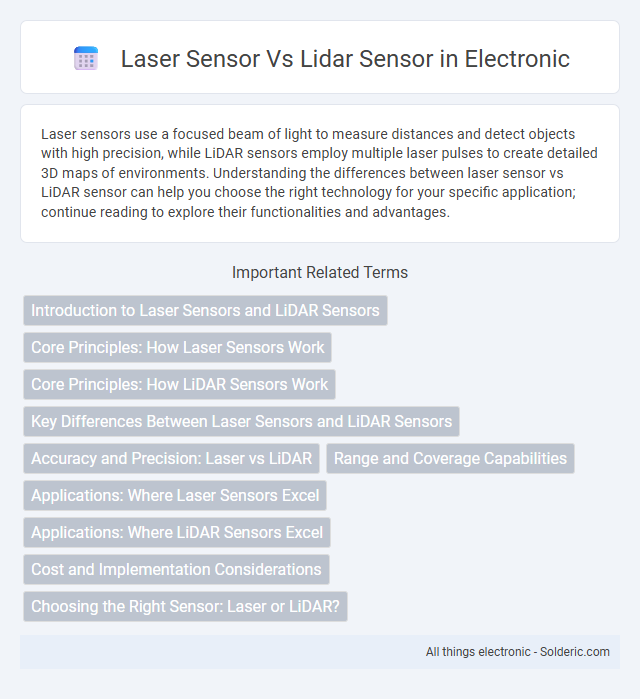Laser sensors use a focused beam of light to measure distances and detect objects with high precision, while LiDAR sensors employ multiple laser pulses to create detailed 3D maps of environments. Understanding the differences between laser sensor vs LiDAR sensor can help you choose the right technology for your specific application; continue reading to explore their functionalities and advantages.
Comparison Table
| Feature | Laser Sensor | Lidar Sensor |
|---|---|---|
| Definition | Device using laser light to detect objects or measure distance. | Light Detection and Ranging system using laser pulses to map environments. |
| Primary Use | Distance measurement, object detection in industrial and consumer applications. | 3D mapping, autonomous vehicles, surveying, and environmental monitoring. |
| Data Output | Simple distance or presence data. | High-resolution 3D point clouds and spatial information. |
| Range | Short to medium range (up to few meters to tens of meters). | Long range capabilities (up to hundreds of meters). |
| Complexity | Simple, typically single beam sensors. | Complex, multiple beams and rotation scanning. |
| Cost | Relatively low cost and compact. | Higher cost due to advanced technology and data processing. |
| Accuracy | Accurate for specific measurements, limited in spatial resolution. | Highly accurate spatial mapping and object detection. |
| Environmental Sensitivity | Performance affected by ambient light and surface reflectance. | Greater resilience to environmental changes but affected by weather conditions. |
Introduction to Laser Sensors and LiDAR Sensors
Laser sensors emit focused laser beams to detect distances and measure object presence with high precision, commonly used in industrial automation and robotics. LiDAR sensors use laser pulses to generate detailed 3D maps by measuring the time it takes for light to reflect back from surfaces, essential for autonomous vehicles and geospatial mapping. Both technologies rely on laser light but differ significantly in application scope and data complexity, with LiDAR offering spatial resolution and environmental modeling capabilities beyond the simpler binary or distance measurements of laser sensors.
Core Principles: How Laser Sensors Work
Laser sensors operate by emitting a focused beam of light, measuring the time it takes for the light to reflect off an object and return, enabling precise distance calculations. Lidar sensors use a similar principle but incorporate multiple laser beams and sensors to create detailed 3D maps of environments by rapidly scanning areas. Your choice between laser sensors and Lidar depends on the required accuracy and application, as laser sensors are often preferred for simple distance measurements, while Lidar excels in complex spatial analysis.
Core Principles: How LiDAR Sensors Work
LiDAR sensors operate by emitting laser pulses and measuring the time it takes for the reflected light to return, allowing precise distance calculation and 3D mapping of environments. This time-of-flight measurement creates high-resolution spatial data crucial for applications like autonomous vehicles and topographic mapping. Understanding how LiDAR sensors work can help you select the right technology for accurate object detection and environmental sensing.
Key Differences Between Laser Sensors and LiDAR Sensors
Laser sensors typically measure distance using a single beam of laser light and provide basic proximity or presence detection, whereas LiDAR sensors employ multiple laser beams and rotating mechanisms to create detailed 3D maps and precise spatial measurements. LiDAR sensors offer higher resolution, broader range, and more accurate environmental mapping compared to laser sensors, making them essential in applications like autonomous vehicles and topographic surveying. Laser sensors are more cost-effective and simpler, commonly used for object detection and industrial automation.
Accuracy and Precision: Laser vs LiDAR
Laser sensors offer high precision by measuring distance using a single laser beam, making them ideal for short-range, focused applications. LiDAR sensors utilize multiple laser beams sweeping across an area, providing greater accuracy and detailed 3D mapping over larger distances. Your choice between laser and LiDAR depends on whether precise point measurements or comprehensive spatial data is required.
Range and Coverage Capabilities
Laser sensors typically offer shorter range and more focused coverage, making them ideal for precise measurements in confined spaces. LiDAR sensors excel with extended range capabilities, often exceeding several hundred meters, and provide 360-degree coverage for comprehensive environmental mapping. Your choice between the two should consider whether you prioritize detailed close-range accuracy or broad-area spatial awareness.
Applications: Where Laser Sensors Excel
Laser sensors excel in precise distance measurement and object detection within industrial automation, robotics, and quality control processes due to their high accuracy and fast response times. Their ability to measure small distances and detect surface irregularities makes them ideal for tasks such as material thickness gauging, position tracking, and presence sensing. Your choice of laser sensors is advantageous for applications requiring fine detail and rapid measurements in controlled environments.
Applications: Where LiDAR Sensors Excel
LiDAR sensors excel in applications requiring precise 3D mapping and environmental modeling, such as autonomous vehicles, forestry management, and urban planning. These sensors provide high-resolution data for accurate distance measurement and object detection over large areas, enhancing navigation and obstacle avoidance. Your projects benefit from LiDAR's ability to capture detailed spatial information in diverse and complex environments.
Cost and Implementation Considerations
Laser sensors generally offer a more cost-effective solution compared to LiDAR sensors due to their simpler design and reduced manufacturing complexity. Implementation of laser sensors typically requires less processing power and integration effort, making them suitable for budget-conscious applications and straightforward use cases. Your choice should consider the trade-off between initial costs and the advanced spatial data capabilities provided by LiDAR technology.
Choosing the Right Sensor: Laser or LiDAR?
Choosing between a laser sensor and a LiDAR sensor depends on your specific application requirements such as range, accuracy, and environmental conditions. Laser sensors are typically best for short-range measurements with high precision, while LiDAR sensors excel in creating detailed 3D maps and detecting objects at longer distances. Understanding your needs for resolution, speed, and budget will help you determine which sensor technology suits your project best.
laser sensor vs lidar sensor Infographic

 solderic.com
solderic.com